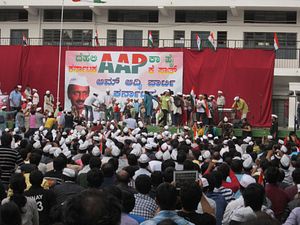India’s Bharatiya Janata Party BJP very much has its eye on a takeover of Congress in the upcoming general election. Spirits are high in the BJP camp and it is confident of success after a decade out of power. It has shone in recent assembly elections and senses that the scene is perfectly scripted for its win. Its candidate for prime minister, Narendra Modi is going state by state with his “NaMo” chant of change.
But is the BJP’s optimism entirely warranted?
The party should recall the 2003-2004 era. The same pattern of winning assembly elections with handsome majorities in a few states was followed by a debacle in the general elections, which saw the dawn of the UPA government. Then, the BJP’s “India Shining campaign” was rejected by the voters. Today, the party has an anti-incumbency advantage and could cut into Congress votes, yet it may be overconfident. The political climate has changed, perhaps more than the party realizes.
Take the emergence of the Aam Aadmi Party (AAP) and its decision to go national with the upcoming general elections. The AAP will not only eat into BJP’s share of anti-incumbent votes but also its core electorate as well. The BJP’s alliance with religious outfits such as RSS, VHP and other affiliates is meanwhile losing relevance.
AAP leader Arvind Kejriwal is an authentic roadblock to BJP’s Narendra Modi, but not because of money power or committed cadres. Nor has he made any attempt to buy media. It is simply because he has challenged Modi on the basic message that BJP was trying to sell to young, enthusiastic but apolitical first-time voters. One such message was the Gujarat model of development. Until the Aam Aadmi Party’s spectacular success in the Delhi Assembly elections the BJP leadership was talking up the Gujarat model as if it were a Marshall Plan. Now talk about the Gujarat model has died down. And the reason is Kejriwal.
What is the Gujarat model of development? It is most certainly not oriented towards the poor and disadvantaged sections of society. Consider the Tatas Nano car plant. The Tatas were given land in a location and at a price to their liking. The value of land surrounding the plant skyrocketed and the farmers made a killing by selling it to those who wanted to set up ancillary industries. Those who were dispossessed of their land received the assurance of a job: watchmen, gate-keeper or security staff. Meanwhile, the large landowners and industrialists were well served and are full of praise for Narendra Modi’s Gujarat model of development.
By contrast, Kejriwal’s concern is for the common man. He talks of water and reduced power tariffs, topics on which Modi has had little to say. Neither has Modi or his party shown any concern for those who live in the slums. Among the very first acts of the new Kejriwal government in Delhi has been to put the discoms (power distribution companies) on the dock, a warning to the corporate world. While Modi’s model calls for a trickle-down approach, the Aam Aadmi way is very much from the bottom up.
Modi’s problem is that he cannot attack Kejriwal the way he is accustomed to taking on his political foes. His support among urban youth will evaporate the moment he attacks Kejriwal, the new hero of young urban Indians. Indeed, Kejriwal has already taken a lot of the sheen off Modi and could dislodge the BJP candidate as favorite among the young vote.
Narendra Modi likes to tell India that better days are on their way. That may be so, but he may be premature in thinking that he’ll be the prime minister delivering them.

































